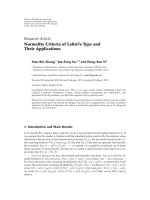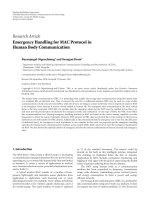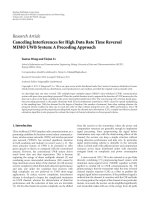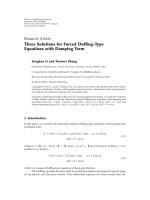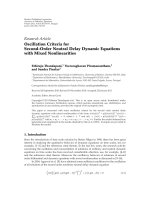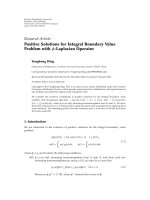Báo cáo hóa học: " Research Article Emergency Handling for MAC Protocol in Human Body Communication" pdf
Bạn đang xem bản rút gọn của tài liệu. Xem và tải ngay bản đầy đủ của tài liệu tại đây (1.21 MB, 6 trang )
Hindawi Publishing Corporation
EURASIP Journal on Wireless Communications and Networking
Volume 2011, Article ID 786903, 6 pages
doi:10.1155/2011/786903
Research Ar ticle
Emergency Handling for MAC Protocol in
Human Body Communication
Buyanjargal Otgonchimeg
1
and Youngmi Kwon
2
1
Department of Policy and Planning, Information Communications Technology and Post Authority (ICTPA),
Ulaanbaatar 15160, Mongolia
2
Department of Information Communication Engineering, Chungnam National University, Daejeon 305-764, Republic of Korea
Correspondence should be addressed to Youngmi Kwon,
Received 30 September 2010; Accepted 27 January 2011
Academic Editor: Arie Reichman
Copyright © 2011 B. Otgonchimeg and Y. Kwon. This is an open access article distributed under the Creative Commons
Attribution License, which permits unrestricted use, distribution, and reproduction in any medium, provided the original work is
properly cited.
The human body communication (HBC) is a technology that enables short range data communication using the human body
as a medium, like an electrical wire. Thus it removes the need for a traditional antenna. HBC may be used as a type of data
communication in body area network (BAN), while the devices are being in contact with body. One of important issues in BAN
is an emergency alarm because it may be closely related to human life. For emergency data communication, the most critical
factor is the time constraint. IEEE 802.15.6 specifies that the emergency alarm for the BAN must be notified in less than 1 sec
and must provide prioritization mechanisms for emergency traffic and notification. As one type of BAN, the HBC must follow
this recommendation, too. Existing emergency handling methods in BAN are based on the carrier sensing capability on radio
frequencies to detect the status of channels. However, PHY protocol in HBC does not provide the carrier sensing. So the previous
methods are not well suitable for HBC directly. Additionally, in the environment that the emergency rate is very low, the allocation
of dedicated slot(s) for emergency in each superframe is very wasteful. In this work, we proposed specific emergency handling
operation for human body communication’s medium access control (HBC-MAC) protocol to meet the emergency requirements
for BAN. We also showed the optimal number of emergency slots for the various combinations of beacon intervals and emergency
rates.
1. Introduction
The IEEE 802.15 Task Group 6 (BAN Group) is developing
a communication standard optimized for low power devices
operating on, in, or around the human body (but not limited
to humans). It covers a variety of applications in medical
area, consumer electronics area, personal entertainment area,
and so forth [1].
A typical wireless BAN consists of a number of inex-
pensive, lightweight, and miniature sensor platforms from
application to application, each featuring one or more
physiological sensors. For example, 12 for cardiac arrhythmia
monitor/recorder, 6 for wireless capsule endoscope, and 12
for insulin pump. The usual number of nodes is expected
to 12 in the standard document. The sensors could be
located on the body as tiny intelligent patches, integrated
into clothing, or implanted below the skin or muscles.
Application in BAN includes permanent monitoring and
logging of vital signs with the goal of supervising the health
status of patients suffering from chronic diseases.
The BAN using human body as a communication
medium has been researched in frequency, transmission
range, node distance, transmitting power, received power,
and energy consumption to form a power and energy
efficient network.
The human body communication (HBC) is a method for
data communication using user’s body as a medium. It does
not require any wire or wireless medium [2]. Two devices are
2 EURASIP Journal on Wireless Communications and Networking
MPEG
Documents
Photo
Touch and play
Display photo
Play MPEG
Display documents
Figure 1: HBC applications.
connected and data is transmitted between them via user’s
body, simply by touch: touch and play (TAP) concept as
shown in Figure 1.
HBC is very suitable for providing a context awareness
service based on TAP. After devices are connected by touch,
identification signals are transmitted through user’s body,
and the type of devices is recognized by each other. For
example, when a user touches an advertisement device with
one hand while holding a PDA in the other hand, the
touch is detected by the advertisement device and the device
sends advertisement contents. Finally, the information can be
downloaded into the PDA via user’s body.
HBC provides these features by utilizing frequency
selective digital transmission (FSDT), a type of direct digital
signaling. Because it does not require analog modulation, the
transmitted data can be reached in the receiver using simple
signal processing: amplifying, filtering, and comparing with
a reference signal. Hence, the communication devices with
FSDT are easy to implement, has low power consumption,
and can be made in small sizes.
Wearable health monitoring systems integrated into a
telemedicine system are novel information technology that
will be able to support early detection of abnormal condi-
tions and prevention of its serious consequences [3]. When
the HBC technologies are applied to the wearable medical
systems, it is very important and essential to immediately
deal with emergency situation because of being fatal to
human. Medical emergency data usually needs high priority
and reliability than nonmedical data. Late reporting of
emergency situation might be fatally harmful. For emergency
data communication, the most critical factor is the time
constraint.
Fortunately, the IEEE 802.15.4 standard reserves a guar-
anteed time slot called GTS for future use [4]. However,
there is no reliable support for on demand and emergency
traffic. Thus, the pure concept of superframe structure of
802.15.4 cannot be applied to emergency data handling.
Other proposals for the emergency handling are basically
based on the CSMA/CA mechanism in BAN. Their medium
is radio signal whose frequencies might be 400 M or 2.4 GHz
and network range is purposed to be up to 5 meters. But
HBC network uses human body as medium of 10
∼30 MHz
frequencies and its PHY layer does not support carrier-
sense capability. The MAC approach is totally different,
and so is the emergency handling. Complete list of MAC
technical requirements are derived from the approval of
TG6 technical requirement document [5]. The documents
mandate emergency management capabilities for the IEEE
802.15.6 specification. The specification must support alarm
state notification across BAN in less than 1 second and must
provide prioritization mechanisms for emergency trafficand
notification. In this work, we proposed specific emergency
handling operation for HBC-MAC to meet emergency
requirements of BAN.
The rest of this paper is organized as follows: Section 2
presents related works for our protocol and Section 3
describes emergency handling for HBC-MAC that we pro-
pose. In Section 4, we present performance analysis and
performance results are shown. In Section 5, finally we give
concluding remarks.
2. Related Works
Several MAC protocols have been developing for IEEE
802.15.6 to meet emergency requirement capacities [6–9].
In Samsung MAC proposal [6], polling-based channel
access mechanism is preferred with the proposed design
approach. Polling is the most suitable channel access mecha-
nism for implant communication. Poiling mechanism for on
body communication eases out integration aspects of chan-
nel access mechanisms. But emergency data handling scheme
should support fast and reliable transfer of emergency data
for implant devices.
Olympus MAC purposed for a star-topology BAN [7]. In
beacon period (BP), coordinator sends beacon periodically
to bind the superframe as shown in Figure 2.Inemergency
access period (EAP), coordinator reserves slots for periodical
guaranteed communication with end devices. At least one
EAP slot is required to poll every end device periodically. If
one EAP slot is not enough, it can be used to reserve more
CFP slots. It is faster way to get contention free period (CFP)
than going through contention access period (CAP).
Ve r s a t i l e M AC [ 8] equips with ETS (emergency data
transmit slot) in TDMA data transmit period. ETS is
highly adaptable to abrupt emergency data and supports
high QoS and reliability. Versatile MAC handles data based
on their priority. Prioritized back-off, CCA, and data slot
allocation are applied to all data transmission to serve higher
priority data first. The ETS is designed for emergency alarm
primarily, but it may be used for nonemergency data. In
case no DTS (data transmission slot) is available, ETS can
be assigned to nonemergency data.
NICT proposed a BAN superframe structure for TG6
[9]. The structure consists of active portion and inactive
portion. The active portion is sequentially divided into three
portions: the beacon, the contention access period (CAP),
and the contention-free period (CFP) as shown in Figure 2.
PTS, CAP, and CFP are called priority access period (PAP).
The CAP supports contention-based channel access for one-
time prompt traffic, such as device association/deassociation,
bandwidth request, and some low duty cycle traffics. The
CFP supports scheduled channel access for periodical traffics
and QoS guaranteed traffics, such as medical waveforms and
EURASIP Journal on Wireless Communications and Networking 3
Beacon
PTS Embedded PAP
Active portion Inactive portion
PAP
CAP CFP
Figure 2: NICT MAC superframe structure.
Beacon
EGTS Superframe without EGTS superframe with EGTS
Superframe groups
CAP CFP
···
···
··· ···
Figure 3: Superframe structure of HBC.
HBCC
DEV
CFP period
Guaranteed transmission
Beacon
{with EGTS}
Wake up
Emergency
occurs
ACK
Figure 4: Emergency alarm occurs within superframe interval with
EGTS.
stream of audio and video. The priority access period (PAP)
is immediately after the beacon in the superframe. The PAP is
comprised of priority time slot (PTS) which is a physical time
period immediately after the beacon, and embedded PAP,
which are the unoccupied slots in both CAP and CFP. The
PTS in the superframe provides guaranteed channel access
only for emergency traffic.
These MAC protocols for IEEE 802.15.6 follow the
emergency requirements. However most of them use carrier
sense operation to get the channel. In HBC, physical layer
protocol does not provide carrier sense capability. A node
cannot sense the signals on a body whether other nodes start
to send a message or not. Thus, existing emergency handling
techniques for BAN are not well suitable for HBC.
3. Emergency Handling for HBC-MAC
Our proposed MAC protocol modified beacon enabled IEEE
802.15.4 protocol maintaining a superframe structure. The
superframe is composed of three parts: beacon, contention
access period (CAP) and contention free period (CFP), as
shown in Figure 3. CFP consists of a number of guaranteed
time slots (GTS) and may include zero or single emergency
guaranteed time slot (EGTS) or several EGTSs.
According to IEEE 802.15.4 contention access protocol
specification, nodes have to perform clear channel assess-
ment (CCA) before transmitting data into the channel. The
use of CSMA/CA provides a reliable solution for wireless
sensor network but it cannot be used for human body
communication because nodes cannot perform CCA in a
favorable way. Therefore within the CAP part of HBC-MAC,
we applied slotted ALOHA scheme without carrier sensing.
Because HBC does not have CS capability, the only way for
a sender to know whether the transmission was successful or
not is to receive a successful ACK frame from the receiver
in a slot period. CAP is used for the irregular management
data and medical report data. CFP is used reservation-
based by request/confirm for bulky and/or regular data
transmissions. The CFP is activated upon request from a
node to coordinator for allocating time slots depending on
the node’s requirement. Upon receiving this request, the
coordinator checks whether there are sufficient resources
and, if possible, allocates the requested time slots.
Emergency data frame is very short; therefore, one time
slot is enough for whole emergency data transmission. From
the view of an irregular short message, it is adequate to be
transmitted in CAP. But from the view of reliability, trans-
mission is not guaranteed for the high-priority emergency
data in CAP. So we allocated emergency GTS (EGTS) in CFP
as if emergency were a regular event. Whenever any device
has an emergency data, it uses EGTS without request to
coordinator. But because it is not a regular event, it is wasteful
to allocate many EGTS slots in every CFP. So we propose
how many EGTS slots are necessary in various conditions of
beacon interval (BI) time and emergency occurrence rates.
As coordinator controls the number of EGTS in CFP, some
CFP may have several EGTSs and some CFP may have
zero EGTS. But usually the maximum number of EGTSs
in a superframe does not exceed one. The existence and
the location of EGTS are broadcasted through Beacon to
4 EURASIP Journal on Wireless Communications and Networking
HBCC
DEV
CFP period
.
.
.
Unguaranteed transmission
Beacon
{without EGTS}
Beacon
{without EGTS}
Beacon
{with EGTS}
Wake up
Wake up
Wake up
Emergency
occurs
Emergency
retransmission
Emergency
retransmission
ACK
CFP period
Unguaranteed transmission
CFP period
Guaranteed transmission
(a)
HBCC DEV
CFP period
.
.
.
Unguaranteed transmission
Beacon
{without EGTS}
Beacon
{without EGTS}
Wake up
Wake up
Emergency
occurs
Emergency
retransmission
ACK
CFP period
Unguaranteed transmission
(b)
Figure 5: (a) Emergency alarm occurs within superframe interval
without EGTS (successful in CAP). (b) Emergency alarm occurs
within superframe interval without EGTS (successful in EGTS).
every node by coordinator. We form a group of superframes
without EGTS along with superframe with one or more
EGTSs into a superframe group.
Case A (Emergency occurs in a superframe interval which
has EGTS). In this case, emergency data is transmitted
immediately using EGTS without any hesitation, as shown
in Figure 4. Devices know whether the EGTS is included in
this superframe or not by listening to the beacon. If an EGTS
has been allocated in the current superframe, the device can
transmit the emergency traffic in the allocated EGTS.
Case B (Emergency occurs in a superframe interval which
doesnot include EGTS). In this case, device doesn’t wait next
superframe interval with EGTS. Once the emergency occurs
within superframe interval without EGTS, device tries to
transmit emergency alarm in CAP duration until it meets
superframe including EGTS. This is to provide a second
opportunity for emergency traffics which occurred in the
superframe interval without EGTS. In HBC, slotted aloha
is used in CAP. Therefore it cannot guarantee successful
transmission. If emergency alarm transmission fails within
all the CAP durations, then it can transmit at guaranteed
time slot, as shown in Figures 5(a) and 5(b).
Table 1: Breakpoint of EGTS superrate to subrate.
N
emer
BI (ms)
62 124 248 496 992 1984 3000
1 1795321/2 1/4
2 95321/2 1/4 1/6
36321/2 1/3 1/6 1/10
45321/2 1/4 1/8 1/13
5421/2 1/3 1/5 1/10 1/15
Case C (Multiple emergencies). In a life critical situation,
multiple alarm sources may activate alarms simultaneously.
Multiple emergencies may happen in EGTS-superframe as
shown in Figure 6, or in multiple without EGTS-superframes
duration as in Figure 7.Inbothcases,emergencydatamay
collide in one EGTS. Even though they will try to get the
slots at the next CAP or EGTS period, it will degrade the
performance of emergency transmission and result in longer
delay.
4. Performance Evaluation
EGTS is too expensive for low data rate emergency data. If
EGTS rate factor is high and emergency alarm message rate
is low then amount of wasted bandwidth will be increased,
because for most of the time, devices do not use allocated
EGTS slots. To reduce overhead of unused EGTSs, we need
to adapt ETGS rate factor while keeping the regulation of
guaranteed low latency for emergency data.
There are two types of EGTS rate factor: superrate and
subrate. The rate shows how many superframes may have at
least one EGTS. For example, when EGTS rate is superrate of
4, it means one EGTS is enough during 4 superframes so as to
meet the emergency latency requirement. When EGTS rate is
subrate of 1/2, it means that one superframe must contain at
least two EGTSs to meet the requirement. EGTS rate factor,
Rate
EGTS
,isobtainedby
Rate
EGTS
=
T
res
BI ∗N
emer
,(1)
where BI is beacon interval, T
res
is guaranteed low latency,
and N
emer
is the number of emergency occurrences during a
superframe group.
In HBC-MAC, suggested length of BI is 62ms. But it may
be varied according to the physical condition or the need of
applications. As it gets longer (e.g., 3 sec), the principle has
to be changed from the superrate to the subrate. We showed
the breakpoints of EGTS superrate and subrate in Ta bl e 1 .
Actually, required EGTS rate factor, Req
EGTS
, depends on
the emergency rate. It is calculated as follows:
Req
EGTS
=
R
alarm
BI ∗N
emer
,(2)
where R
alarm
is the emergency rate showing how many alarms
happen in an unit time. This emergency rate is very low. It
may occur once a week, once a month, and so on.
EURASIP Journal on Wireless Communications and Networking 5
Collision
Superframe with EGTS
···
··· ··· ···
Figure 6: Multiple emergency alarms occur in a same superframe with EGTS.
Emergency
alarm 1
Emergency
alarm 2
Superframe without EGTS
Collision
···
···
··· ···
Figure 7: Multiple emergency alarms occur in a same superframe group.
18
123 4 5
16
Subrate
Superrate
14
12
10
8
6
4
2
0
2
4
6
8
10
12
14
16
18
20
The number of simultaneous emergencies
BI
= 62ms
BI
= 496ms
BI
= 3000ms
BI
= 124ms
BI
= 992ms
BI
= 248ms
BI
= 1984ms
Figure 8: EGTS superrate and subrate factor by traffic.
Based on the slot time, we can calculate the overhead
time. So T
overhead
is calculated as follows:
T
overhead
=
Req
EGTS
−Rate
EGTS
∗
Slot time. (3)
5. Performance Analysis
5.1. Simulation Parameters and Assumptions. In this work,
we considered only periodic and real-time short emergency
alarm message. We considered only one EGTS enough for
whole emergency data transmission. Also we assumed that
0
1
2
3
Number of superrame
4
5
6
7
8
9
10
×10
6
once
an hour
once every
6 hours
once every
12 hours
once every
2days
once
per day
once a week
Emergency rate
58065
29032
19355
14516
11613
348387
174194
116129
87097
69677
696774
348387
232258
174194
139355
1393548
696774
464516
348387
278710
2787097
1393548
929032
696774
557419
8593548
4296774
2864516
2148387
1718710
N
emer = 1
N
emer = 2
N
emer = 3
N emer = 4
N
emer = 5
Figure 9: Required EGTS rate factor by emergency traffic condition
with BI
= 62 ms.
the maximum number of nodes which make emergency
alarms simultaneously is 5. Simulation parameters are shown
in Ta b l e 2 .
5.2. Result Analysis. Figure 8 shows EGTS superrate and sub-
rate factor to satisfy emergency requirement. For example, in
the case that only one emergency occurs with BI of 62 ms,
to allocate one EGTS per 17 superframes is enough to meet
the emergency requirements. When 5 emergencies occur
during operation with BI of 3000 ms, we can see that every
superframe must include 15 EGTSs to satisfy the emergency
requirement.
Required EGTS subrate and superrate factor based on
the emergency rate condition is shown in Figure 9.Ifthe
emergency traffic rate decreases or multiple emergencies do
not happen frequently, then EGTS rate factor should be
higher. In this case, wastage bandwidth increases, therefore
overhead time of unused EGTSs increases, as shown in
Figure 10.
6 EURASIP Journal on Wireless Communications and Networking
0
200
400
600
800
1000
1200
1400
1600
(sec)
once
an hour
once every
6 hours
once every
12 hours
once every
2days
once
per day
once a week
Emergency rate
10
5
3
2
2
60
30
20
15
12
120
60
40
30
24
240
120
80
60
48
479
240
160
120
96
1478
739
493
370
296
N
emer = 1
N
emer = 2
N
emer = 3
N
emer = 4
N
emer = 5
Figure 10: Overhead time of unused EGTS with BI = 62 ms.
Table 2: Simulation parameters.
Number of emergency at
same superframe group
N
emer
1, 2, 3, 4, and 5
Emergency data rate R
alarm
Var iable
Guaranteed low latency T
res
1sec
Beacon interval BI
62, 124, 248, 496, 992,
1984, 3000 ms
Slot time A Slot Time 172 us
6. Conclusion
The existing concept of operation and superframe structure
of IEEE 802.15.4 or IEEE 802.15.6 cannot be directly applied
to emergency data handling in HBC-MAC protocol due to
the lack of CS capability in HBC.
In this work, we proposed a specific emergency handling
operation for HBC-MAC using EGTS to meet the emergency
requirements from IEEE 802.15.6 BAN. Because EGTS is too
expensive and wasteful for the low data rate emergency, we
showed the adequate number of emergency slots to reduce
overhead. We formulated ETGS rate factor according to the
guaranteed low latency of emergency data.
References
[1] IEEE 802.15 WPAN, “Task Group 6 (TG6) Body area networks
documents,” />[2] J.S.Parketal.,“Samsung-ETRI’sEFCProposalforHBCPHY,”
IEEE P802. 15-10-0049-02-0006, Jan 2010.
[3] R.S.H.Istepanian,E.Jovanov,andY.T.Zhang,“Introduction
to the special section on m-Health: beyond seamless mobility
and global wireless health-care connectivity,” IEEE Transactions
on Information Technology in Biomedicine, vol. 8, no. 4, pp. 405–
414, 2004.
[4] IEEE Computer Society, “IEEE Standard 802.15.4a-2007,”
August 2007.
[5] B. Zhen, M. Patel, S. H. Lee, E. T. Won, and A. Astrin, “TG6
Technical Requirements Document (TRD),” IEEE P802.15-08-
0644-09-0006, September 2008.
[6] R. K. Patro et al., “Samsung MAC proposal for IEEE 802.15
TG6- Body Area Networks,” IEEE P802.15-09-0344-01-0006,
May 2009.
[7] G. Ding and (Olympus Communication Technology of Amer-
ica), “Olympus MAC proposal for IEEE P802.15.6,” IEEE
802.15-09-0311-00-0006, May 2009.
[8] J.S.Yoon,G.S.Ahn,M.J.Lee,andS.S.Joo,“VersatileMACfor
Body Area Network,” IEEE P802.15-0337-01-0006, June 2009.
[9] B. Zhen, G. Sung, H. Li, and R. Kohno, “NICT’s MAC proposal
to IEEE 802.15.6- document,” IEEE P802-15-0814-02-0006,
November 2009.
